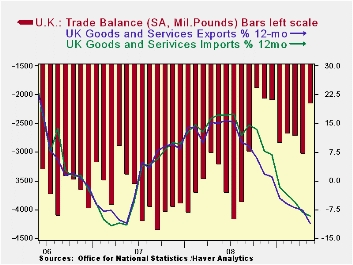 Global| Jul 09 2009
Global| Jul 09 2009UK Trade Picture: Better In Month But In Flux
Summary
The UK trade balance shrank to 6.26bln sterling in May from 7.14bln in April. Exports edged lower, while imports fell by 4% in May. Export and import trends do not show very dramatic signs of change. Exports are declining by a bit [...]

The UK trade balance shrank to 6.26bln sterling in May from
7.14bln in April. Exports edged lower, while imports fell by 4% in May.
Export and import trends do not show very dramatic signs of change.
Exports are declining by a bit less than imports and their rate of
decline is more persistently losing that negative edge, but that
remains a very gradual process. For imports the declines over various
horizons are still large. The pace of decline over three months is less
than for six months; the drop over six months shows acceleration in the
drop compared to 12 months. Import trends are still a chaotic.
Exports and imports of road vehicles have picked up, perhaps
in response to various vehicle purchase plans in effect in the UK and
around Europe. Vehicle sales have picked up because of such incentives.
Trends for capital goods shipments are worsening for exports
and for imports over 12- 6- and 3-months.
For other groups of exports and imports the patterns are still
too varying to categorize.
German trade reported a bounce in exports with imports still
falling in May. German orders (especially foreign orders) and
industrial output have been on the mend in other recent reports. Still,
it is too soon to throw the UK figures in with that lot and call them
positive. The UK trade accounts still have divergent trends and the
improvement in trade has given way to deterioration and then to more
improvement. It is too much in flux to be sure of. Both export and
import trends are still under clear downward pressure Yr/Yr. There is
no solid sign of trade flows returning to an expansion path any time
soon for the UK.
| UK Trade trends for goods | |||||
|---|---|---|---|---|---|
| m/m% | % Saar | ||||
| May-09 | Apr-09 | 3M | 6M | 12M | |
| Balance* | - £ £6.26 | - £ £ 7.14 | - £ £6.62 | - £ £ 6.89 | - £ £ 7.34 |
| Exports | |||||
| All Exp | -0.8% | -1.5% | -12.3% | -13.7% | -14.1% |
| Capital gds | -2.8% | -8.0% | -34.3% | -28.1% | -16.1% |
| Road Vehicles | 14.5% | -8.3% | -10.6% | -39.8% | -35.0% |
| Basic Materials | -22.2% | 11.6% | -33.3% | -3.6% | -44.4% |
| Food Feed Bev & Tbco | -0.6% | 4.2% | 11.9% | 17.5% | 9.2% |
| IMPORTS | |||||
| All IMP | -4.0% | 1.5% | -16.1% | -20.1% | -15.3% |
| Capital gds | -7.5% | -0.7% | -42.6% | -37.1% | -19.9% |
| Road Vehicles | 5.5% | -5.6% | -9.4% | -22.5% | -38.4% |
| Basic Materials | -2.0% | -2.0% | -16.5% | -39.8% | -36.2% |
| Food Feed Bev & Tbco | -2.1% | 5.5% | 8.2% | 5.7% | 9.3% |
| *Stg Blns; mo or period average | |||||
Robert Brusca
AuthorMore in Author Profile »Robert A. Brusca is Chief Economist of Fact and Opinion Economics, a consulting firm he founded in Manhattan. He has been an economist on Wall Street for over 25 years. He has visited central banking and large institutional clients in over 30 countries in his career as an economist. Mr. Brusca was a Divisional Research Chief at the Federal Reserve Bank of NY (Chief of the International Financial markets Division), a Fed Watcher at Irving Trust and Chief Economist at Nikko Securities International. He is widely quoted and appears in various media. Mr. Brusca holds an MA and Ph.D. in economics from Michigan State University and a BA in Economics from the University of Michigan. His research pursues his strong interests in non aligned policy economics as well as international economics. FAO Economics’ research targets investors to assist them in making better investment decisions in stocks, bonds and in a variety of international assets. The company does not manage money and has no conflicts in giving economic advice.






